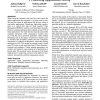Free Online Productivity Tools
i2Speak
i2Symbol
i2OCR
iTex2Img
iWeb2Print
iWeb2Shot
i2Type
iPdf2Split
iPdf2Merge
i2Bopomofo
i2Arabic
i2Style
i2Image
i2PDF
iLatex2Rtf
Sci2ools
ACMDIS
2010
ACM
2010
ACM
The CLOTHO project: predicting application utility
When using the computer, each user has some notion that "these applications are important" at a given point in time. We term this subset of applications that the user values as high-utility applications. Identifying high-utility applications is a critical first step for Task Analysis, Time Management/Workflow analysis, and Interruption research. However, existing techniques fail to identify at least 57% of these applications. Our work directly associates measurable computer interaction (CPU consumption, window area, etc.) with the user's perceived application utility without identifying task. In this paper, we present an objective utility function that accurately predicts the user's subjective impressions of application importance, improving existing techniques by 53%. This model of computer usage is based upon 321 hours of real-world data from 22 users (both professional and academic). Unlike existing approaches, our model is not limited by a pre-existing set of a...
| Added | 05 Dec 2010 |
| Updated | 05 Dec 2010 |
| Type | Conference |
| Year | 2010 |
| Where | ACMDIS |
| Authors | Joshua M. Hailpern, Nicholas Jitkoff, Joseph Subida, Karrie Karahalios |
Comments (0)

